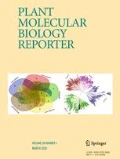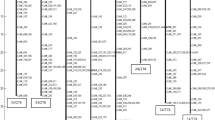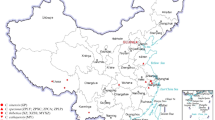Abstract
The ever increasing body of information on genomics and functional genomics from model plants, and new tools of comparative genomics, provide an opportunity to accelerate the development of molecular markers for increasing the efficiency of breeding of lesser studied crops, so-called “orphan crops.” Conserved ortholog set (COS) markers represent orthologous genes in widely divergent plant species, and are currently the principal tool of choice for comparative genomics. EST sequences of 3 drought tolerance related genes—chalcone synthase (CHS), dihydroflavonol-4-reductase (DHRF) and drought responsive element binding factor 1 (DREB-1) fromMusa sp—were used to identify cassava EST homologs that were then scanned against the Arabidopsis genome database to identify them as COS markers. The CHS and DHRF ESTs were demonstrated to be COS markers, while the DREB EST was shown to belong to a gene family. The three genes were evaluated as single strand conformation polymorphism—single nucleotide polymorphism (SSCP-SNP) markers in the parents of an F1 mapping population and subsequently in the progenies. The DHRF COS marker mapped to linkage group R of the female-derived map while the DREB-1 EST mapped at an end of the male-derived linkage group K. The CHS COS marker could not be mapped because it was not polymorphic in the parents of the mapping population. These new marker tools should accelerate the development of markers associated with genes controlling traits of agronomic interest via the candidate gene loci (CGL) QTL-mapping approach.
Similar content being viewed by others
Abbreviations
- CGL:
-
candidate gene loci
- CHS:
-
chalcone synthase
- COS:
-
conserved ortholog set
- DHRF:
-
dihydroflavonol-4-reductase
- DREB:
-
drought responsive element binding factor
- EST:
-
expressed sequence tag
- QTL:
-
quantitative trait locus
- RAPD:
-
random amplification of polymorphic DNA
- RFLP:
-
restriction fragment length polymorphism
- SDRF:
-
single-dose fragment restriction
- SNP:
-
single nucleotide polymorphism
- SSCP:
-
single strand conformation polymorphism
- SSR:
-
simple sequence repeat
References
Anderson JV, Delseny M, Fregene MA, Jorge V, Mba C, Lopez C, Restrepo S, Soto M, Piegu B, Verdier V, Cooke R, Tohme T, and Horvath DP (2004) An EST Resource for Cassava and other Species ofEuphorbiaceae. Plant Mol Biol 56: 527–539.
Bassam BJ, Caetano-Anolle, SG, and Gresshoff PM (1991) Fast and sensitive silver staining of DNA in polyacrylamide gels. Anal Biochem 196: 80–83.
Bertin I, Zhu JH, and Gale MD (2005) SSCP-SNP in pearl millet-a new marker system for comparative genetics. Theor Appl Genet 110: 1467–1472.
Cho RJ, Mindrinos M, Richards DR, Sapolsky RJ, Anderson M, Drenkard E, Dewdney L, Reuber TL, Stammers M, Federspiel N, Theologis A, Yang WH, Hubbell E, Au M, Chung EY, Lashkari D, Lemieux B, Dean C, Lipshutz RJ, Ausubel FM, Davis RW, and Oefner PJ (1999) Genome-wide mapping with biallelic markers inArabidopsis thaliana. Nat Genet 23: 203–207.
Fregene M, Angel F, Gomez R, Rodriguez F, Chavarriaga P, Roca W, Tohme J, and Bonierbale M (1997) A molecular genetic map of cassava (Manihot esculenta Crantz) Theor Appl Genet 95: 431–441.
Fulton TM, Van der Hoeven R., Eannetta NT, and Tanksley (2002) Identification, Analysis, and Utilization of Conserved Ortholog Set Markers for Comparative Genomics in Higher Plants. Plant Cell 14: 1457–1467.
Hayashi M, Takahashi H, Tamura K, Yu JL, Kawai-Yamada M, Tezuka T, and Uchimiya H (2005) Enhanced dihydroflavonol-4-reductase activity and NAD homeostasis leading to cell death tolerance in transgenic rice. Proc Natl Acad Sci USA 102: 7020–7025.
Jorge V, Fregene MA, Duque MC, Bonierbale MW, Tohme J, and Vedier V (2000) Genetic mapping of resistance to bacterial blight disease in cassava (Manihot esculenta Crantz). Theor Appl Genet 101: 865–872.
Jorge V, Fregene M, Velez CM, Duque MC, Tohme J, and Verdier V (2001) QTL analysis of field resistance toXanthomonas axonopodis pv.manihotis in cassava. Theor Appl Genet 102: 564–571.
Kosambi DD (1994) The estimation of map distances from recombination values. Ann Eugen 12: 172–175.
Lander ES, Green P, Abrahamson J, Barlow A, Daly MJ, Lincoln SE, and Newburg L (1987) MAPMAKER: An Interactive Computer Package For Constructing Primary Genetic Linkage Maps Of Experimental And Natural Populations. Genomics 1: 174–181.
Li XP, Tian AG, Luo GZ, Gong ZZ, Zhang JS and Chen SY (2005) Soybean DRE-binding transcription factors that are responsive to abiotic stresses. Theor Appl Genet 110: 1355–1362.
Lopez CE, Jorge V, Piegu B, Mba CH, Cortes D, Restrepo S, Soto M, Laudié M, Berger CH, Cooke R, Delseny M, Tohme J, and Verdier V (2004) A unigene catalogue of 5700 expressed genes in cassava. Plant Mol Biol 56: 541–54.
Lopez C, Piégu B, Cooke R, Delseny M, Tohme J, and Verdier V (2005) Using cDNA and genomic sequences as tools to develop SNP strategies in cassava (Manihot esculenta Crantz). Theor Appl Genet 110: 425–431.
Lyman RF and mackay TFC. 1998. Candidate quantitative trait loci and naturally occurring phenotypic variation for bristle number indrosophila melanogaster: the delta-hairless gene region. Genetics 149: 983–998.
Martins-Lopes, Zhang H and Koebner R (2001) Detection of Single Nucleotide Mutations in Wheat Using Single Strand Conformation Polymorphism Gels. Plant Mol Biol Rep 19: 159–162.
Mba REC, Stephenson P, Edwards K, Melzer S, Mkumbira J, Gulberg U, Apel K, Gale M, Tohme J, and Fregene M (2001) Simple sequence repeat (SSR) markers survey of the cassava (Manihot esculenta Crantz) genome: towards an SSR-based molecular genetic map of cassava. Theor Appl Genet 102: 21–31.
Okogbenin E and Fregene M (2003) Genetic analysis and QTL mapping of early root bulking in an F1 population of non-inbred parents in cassava (Manihot esculenta Crantz). Theor Appl Genet 107: 1452–1462.
Orita M, Iwahana H, Kanazana H, Hayashi K, and Sekiya T (1989) Detection of polymorphisms of human DNA by gel electrophoresis as single-strand conformation polymorphisms. Proc Natl Acad Sci USA 86: 2766–2770.
Riechmann JL and Meyerowitz EM (1998) The AP2/EREBP family of plant transcription factors. Biol Chem 379: 633–46.
Scheffler BE, Reddy AR, Hoffmann I, and Wienand U (1995) Chalcone Synthase cDNA fromOryza sativa. Plant Physiol 109: 722.
Author information
Authors and Affiliations
Corresponding author
Rights and permissions
About this article
Cite this article
Castelblanco, W., Fregene, M. SSCP-SNP-based conserved ortholog set (COS) markers for comparative genomics in cassava (Manihot esculenta crantz). Plant Mol Biol Rep 24, 229–236 (2006). https://doi.org/10.1007/BF02914061
Issue Date:
DOI: https://doi.org/10.1007/BF02914061




